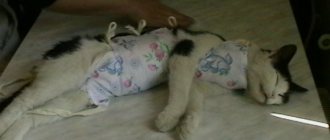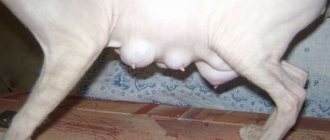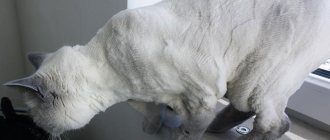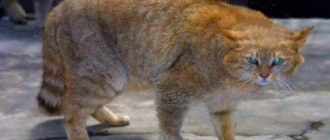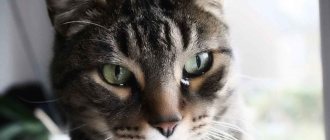Why does a cat shake with small tremors: reasons, what to do, when to contact a veterinarian
Owners of cats may encounter an unusual condition of the animal: the cat is trembling as if it is cold.
The owners see the reason that the pet is simply cold. But the frequent repetition of this phenomenon serves as a signal that pathological processes are developing in the animal’s body, the animal is experiencing severe stress, and has become infected with an infectious disease.
Unreasonable trembling should be a reason to contact a veterinary clinic to a specialist, where the doctor will identify the presence of disorders and prescribe treatment.
When cats can shake
Cats can tremble not only in their sleep, but also while awake. The main problem for the owner is determining the cause of the trembling and whether any disease is present.
If this phenomenon occurs quite often, it is necessary to determine the room temperature. If the room temperature is not comfortable for the pet, measures should be taken to provide warmth to the pet. The measure consists of raising the room temperature or providing the animal with warm bedding and eliminating drafts.
The cat is shaking - the main reasons
Tremor (whole body trembling) is a rhythmic muscle contraction caused by internal or external factors, such as:
- change in temperature,
- reaction to stressful situations,
- sexual arousal,
- pathology.
- Cold, heat.
If the animal begins to tremble, having wet its skin, this behavior is normal. The furry predator is able to withstand low air temperatures, but does not tolerate humidity well.
The problem is especially urgent for a kitten; self-regulation of the body in babies is still weak, they are especially sensitive to humidity, but the development of seizures indicates a serious illness. Overheating of the body can lead to heatstroke, which in turn leads to tremors.
Attentive owners notice that the pet’s behavior when seeing unfamiliar people or things looks like this: the body begins to shake from small tremors. Fear of the unknown, especially fear, causes symptoms such as tremors of the limbs and involuntary urination.
Strong emotions (negative or positive) can cause involuntary muscle contractions. The cat is trembling not because of poor health, but from joy after a long separation from the owner, and so on.
An animal in heat often trembles when it sees an individual of the opposite sex. The hormonal surge that begins when looking at a potential partner leads to trembling. If trembling occurs in an animal after sterilization, you should have your pet checked by a veterinarian.
Emotional excitement
What to do if your cat is shaking? First you need to find out the reason, and only then take some action. For example, periodic trembling in an animal may appear due to certain emotional states. For example, the cat experienced severe fear, discomfort from the appearance of strangers in the apartment, and aggression arose. The appearance of yeast in this case is explained by the tension that engulfs the animal. At this moment, the cat is like a stretched string that is about to snap. It is because of this that she begins to tremble.
Note that not only negative emotions can cause such conditions in a pet. For example, a cat that is experiencing bliss may also tremble periodically. Some owners notice that when they return after work and the cat is bored, rubs, purrs, and literally shakes with joy. This is the normal state of the animal. Therefore, you should not leave your pet for a long time if it is so hard for you to be separated from you.
When to contact a veterinarian
If your cat often trembles and there are additional signs of ill health (increased aggression, lethargy, frequent bowel movements, vomiting, constipation), you should immediately visit a veterinary clinic.
- Tremor can be one of the symptoms when affected by toxic substances. The poison in the cat’s body is absorbed gradually, slight trembling is replaced by convulsions.
- Minor trembling coupled with lethargy may indicate the development of an infection.
- Infection with worms is accompanied by constipation or diarrhea, perversion of taste, and chills.
- Shaking of the entire body and head may indicate internal injuries.
- A tick bite may also be accompanied by trembling.
- Chills, accompanied by coughing, sneezing, and discharge from the sinuses, indicate damage to the bronchi and pneumonia.
- Damage to the meninges as a result of the development of meningitis, tick-borne encephalitis, borreliosis, rabies, is often accompanied by severe trembling and convulsions.
Pathological causes
In some cases, kittens begin to tremble due to pathological processes occurring in the body. Among the most common are the following
:
These are the main reasons why a kitten may be shaking. If the baby feels generally fine, and there are no other alarming symptoms, and the tremor goes away as quickly as it started, there is no need to worry too much, but it is worth watching the animal.
In cases where additional signs are present, the kitten looks sick or tired, you need to show it to a specialist. Timely identification of the cause can save your pet's life.
If the owner notices that the cat’s paws are shaking, then it is necessary to urgently visit a veterinarian. This phenomenon should not be ignored. It also happens that a cat’s hind legs are shaking, but the front legs are not affected by the disorder. The tremors in the hind limbs that your cat suffers from will not go away on their own. If you start a violation, then there is a danger that gradually the paws, which at first only shake, will begin to fail, and the cat will simply end up half paralyzed, forced to lie down all the time. No owner would want such an outcome, and therefore, naturally, will make every effort to restore the normal state of the pet. It is important to know that when the paws shake, the trembling in them is not a cramp.
When asked why the owner sometimes notices tremors in the limbs of a kitten or an adult pet, the answer can be completely different, since the reasons range from harmless to pathological.
What to do if your cat is shaking
If an animal exhibits involuntary trembling, the owner should:
- analyze previous events,
- exclude external factors (hypothermia, overheating, fear, sexual overstimulation),
- contact a veterinarian to diagnose the disease and begin treatment in time.
Do you know what to do if your pet is shaking due to external reasons?
- In case of hypothermia, warm the animal, dry the skin, and massage the body.
- In case of overheating, cool the body with cool compresses and inject water into the oral cavity from a syringe without a needle.
- In case of stress, calm the pet down and protect it from objects that cause fear.
- During sexual hunting, you need to carefully monitor the pet’s condition and give medications that reduce attraction to the opposite sex.
More serious reasons
Thinking about why a cat is trembling, I would like to talk about more serious reasons for this phenomenon. Trembling may be a symptom of kidney disease. If there is a possibility or predisposition of your animal to such a disease, then you should definitely visit a veterinarian and conduct the necessary examination.
Also, trembling in the limbs can be a concomitant symptom of a disease such as rhinotracheitis. But if it is a viral infection, then the animal will also experience: nasal discharge, high fever, hoarseness and possible vomiting.
If then her body may tremble slightly. Symptoms of this disease also include: apathy, “glassy” eyes, increased salivation. The cat must be treated, otherwise paralysis may occur.
Why is the cat shaking?
Trembling in a pet is a signal that some processes are happening in the body. The trembling can be large or small and sometimes not entirely noticeable under a thick coat. You can feel this symptom if you put your hand on the cat.
There are many reasons why a cat trembles, but it is impossible not to notice it. Having noticed that your cat has chills or tremors in the body, you need to understand what caused this. It could be simple hypothermia, or it could be a more serious internal pathology.
It is worth remembering that it is impossible to do without the qualified assistance of a veterinary medicine doctor, since it is not possible to determine the exact cause of tremors in a cat.
The cat's paws are shaking
Trembling paws means a lack of calcium in the body. To cure your cat, start giving him vitamin complexes with microelements. Typically, such courses last 10 days.
Kidney diseases can also cause trembling in the paws. In this case, give the cat the drug “Cat Erwin”. This medicine is made from natural ingredients and is absolutely harmless to animals. It will relieve inflammation and have a diuretic effect.
Trembling limbs can be a symptom of a serious illness, for example, rhinotracheitis. In this case, you need to contact a veterinarian.
But it is better not to self-medicate, but to immediately contact a veterinarian.
Domestic animals (particularly cats), like people, sometimes experience tremor (shaking). There are many reasons for its occurrence. Before helping your pet, you need to figure out why the cat is trembling.
Reasons why a cat may tremble
Trembling, or in other words tremor, is a condition indicating contraction of muscle fibers. If a cat is trembling, this does not always indicate the development of pathology. The main causes of trembling in a cat are:
- Specific reaction of the body to cold
. A cat may shiver after a bath or after long walks outside during the cold season. Tremors can be caused by severe hypothermia of the body during prolonged exposure to the street, or by a slight decrease in temperature when the room is cool. You can prevent your pet from trembling as a result of hypothermia by avoiding long walks in the cold. Cats with short hair or hairless breeds get cold especially often. Owners of such pets should take more careful care of their animals. - Stressful state.
Trembling in a cat may appear as a response to a strong emotional outburst or stress. The appearance of tremors in a cat may be associated with the appearance of new animals in the house, or when transporting the pet in a carrier. At the same time, the cat's tail shakes, thus the animal signals its nervous state. You can eliminate tremors by preventing the development of stress in your cat and calming it as much as possible. - Sexual arousal
. During the period of sexual heat, a cat may experience characteristic trembling against the background of a hormonal surge. During a cat's heat, all of its senses are heightened, they react more vividly to various smells, and may behave strangely and restlessly. This condition in a cat can be prevented by timely surgical intervention to remove the reproductive function. - Natural biochemical processes in the body
. While the animal is resting, the body continues its work. Biological processes actively occur in the body of a sleeping cat, accompanied by trembling during sleep in the entire body, or some parts. Thus, it has been observed that not only dogs, but also cats are capable of shaking their hind legs in their sleep.
Tremors can also be caused by dangerous pathological changes and serious illnesses. Thus, in the absence of a properly balanced diet for an animal with a pronounced deficiency of essential vitamin and mineral complexes, degenerative processes develop.
It has a particularly acute effect on the appearance of tremors in a cat, a disturbance in the absorption and flow of calcium into the body. Such violations can be prevented by carefully choosing a diet that is balanced with all the necessary nutrients.
Trembling in a domestic cat can also develop against the background of such a dangerous viral infection as rhinotracheitis. The pathology is accompanied by serious damage to the organs of vision and respiratory tract. Lack of assistance during the development of the disease can cause serious complications, in some cases threatening the normal functioning of the pet.
Another reason for the appearance of tremors in cats is the presence of internal parasites (helminthiasis).
The appearance of trembling in a cat after surgery is a fairly common occurrence and is not evidence of a pathological condition. When a cat shakes after sterilization, this indicates that the body is emerging from a state of anesthesia (deep sleep) and is coping with the remnants of anesthesia.
The first few hours after the sterilization operation, tremors in the pet’s body are normal. If the cat trembles after sterilization for a long time (more than 6 hours in a row), you should consult a veterinarian. This is due to the fact that such trembling may indicate the development of internal bleeding.
When to contact a veterinarian
When a cat trembles as a result of a pathological condition and the tremor is not associated with physiological processes, it is necessary to show the pet to a veterinary specialist. This will allow you to quickly determine the cause of the pathology and prescribe adequate appropriate treatment.
Quite common pathologies diagnosed in domestic cats in veterinary medicine are:
- The cat is shaking with small tremors
due to a herpes virus infection or rhinotracheitis virus. In addition to trembling, the animal experiences discharge from the eye area and respiratory tract, a characteristic cough and attacks of eruption of gastric contents. - The cat trembles all over
with helminthiasis, which threatens the life of the animal. Infection with dangerous helminths is accompanied by processes of intoxication of the body, provoking the development of tremor. In some cases, trembling is not observed in the entire body, but only in the hind or forelimbs. - Inflammatory process in the bladder.
Cystitis causes pain during the act of urination, which leads to tremors from pain. The same symptom appears in domestic cats with the development of urolithiasis. - Ear diseases
- various otitis and otodectosis, cause itching and discomfort in the cat, causing tremors (the cat shakes its head). In the absence of timely treatment, the pet may lose hearing, and in the most dangerous cases, when the eardrum is perforated due to bacterial otitis, the membranes of the brain may become infected. - The appearance of trembling in the head area
may indicate not only damage to the ear canal. As a rule, the cause of head tremor and tremors in the body can be encephalitis, pathologies of the cerebellum, and dangerous injuries to the skull. - Tremor in the sacral region
can be a signal of disorders in the spine caused by compression fractures, tumor processes, and deformations in the intervertebral discs.
When should you worry?
If a cat's paws twitch in its sleep, this is not always a cause for alarm. You should keep an eye on your pet. You need to observe not so much in a dream as at the moment of awakening. The state of the animal is immediately visible: if the cat is happy, she has the perky look of a hooligan or, on the contrary, the mysterious arrogant look of an empress, she stretches and yawns, purrs briefly and abruptly.
You should be concerned if your cat twitches too often during sleep. When your pet looks unhappy, tired and lethargic when waking up, you should immediately contact a veterinarian.
Doctors' help is also required in cases where a cat twitches its paws in its sleep and then wakes up sweaty and with wet fur. This is a symptom of internal problems in the body, which may be related to hormonal balance or kidney function.
Persians who eat dry food often suffer from kidney failure and urolithiasis. Persian cats prone to such ailments always first begin to twitch and sweat, and only after some time do characteristic symptoms appear - changes in the concentration, color and smell of urine.
When observing a sleeping twitching cat, you need to carefully touch it, trying not to wake the pet. This should be done in order to understand whether the animal has a spasm - contraction of muscle fibers. It is impossible to determine this visually. If your pet's body or legs are cramping, you should immediately consult a doctor.
Reasons why a cat may tremble
Non-pathological underlying causes of strange muscle contractions are not dangerous and can be easily prevented by eliminating predisposing factors.
Joy and positive emotions
There are several reasons why a cat trembles:
- reaction to a favorite treat;
- excitement during games;
- interest in birds or insects seen through the window;
- joy at the sight of the owner or a new toy.
Domestic cat
In these cases, the deviation is temporary and goes away on its own after a short period.
The blanket is in the way
Some pets hate any foreign things placed on them.
Cat in a blanket
Foreign blankets include blankets that are put on after surgery. By contracting muscles, the cat tries to get rid of discomfort.
The cat is frozen
Comfortable temperature conditions for furry pets include the following indicators:
- for newborn babies - 31 degrees and above;
- for older kittens - 24 degrees.
Wide open windows, lack of heating, and drafts cause the cat to tremble, trying to warm up. Secondary symptoms of hypothermia include drowsiness, apathy, decreased heart rate, breathing and temperature.
Fatigue after exercise
Prolonged physical activity, chasing a butterfly or a bird leads to a problem. The deviation resembles the reaction of the human body to excessive physical activity: voluntary contractions of the leg muscles after running. After rest, the symptoms disappear.
The animal got scared
If a cat is shaking with small tremors, she meows continuously, tries to hide in a secluded place, behind the sofa, and the hair on the back of her neck stands on end, then she is simply scared.
Fear is provoked both by the arrival of strangers and by a working vacuum cleaner or mixer.
Sexual arousal
At the peak of hormone production, cats shake, make loud noises, and rub against their legs or furniture.
It is easy to recognize sexual arousal: males begin to actively mark their territory, females experience swelling in the genital area.
Puberty of a cat
Why does a cat shake after 5 months: one of the root causes includes growing up and puberty. In young animals, the unusual condition causes unreasonable fear and stress.
Trembling as a warning sign
The pathological appearance of tremors is associated with a variety of diseases. Without diagnosis, it is difficult to determine the original source - many pathologies have similar symptoms.
Trembling croup and generalized tremor
Muscle contractions are the consequences of damage to the spinal column, deformation changes in its structure, stenosis in the spinal canal, malignant or benign neoplasms.
Inflammatory process
The penetration of pathogenic microflora provokes inflammation and febrile syndrome. Most often, the phenomenon occurs in the postoperative period and manifests itself:
- swelling of the suture;
- suppuration and release of ichor from the wound;
- vomiting, refusal to eat;
- pet's indifference.
Calcivirus infection
A healthy cat may shiver as if it were cold with a latent form of the disease. When the disease becomes chronic, it leads to the appearance of a characteristic clinical picture:
- discharge from the nasal passages and organs of vision;
- intermittent claudication, lethargy, apathy;
- Immunity impairment provokes relapse and transition to the acute phase of the pathology.
Central nervous system disorders
Why do cats tremble when the central nervous system is damaged: the source may be epilepsy, meningitis or encephalitis. Common symptoms of these diseases include:
- rapid breathing and increased heart rate;
- bouts of vomiting;
- strong secretion of saliva;
- convulsions, unsteadiness of gait;
- feverish syndrome, anxiety.
Salivation
Subclinical form of panleukopenia
The course of the pathological process leads to the occurrence of clinical manifestations:
- lethargy, increased temperature;
- refusal to eat and drink - against the background of constant thirst;
- attacks of vomiting;
- increased gas formation and diarrhea.
The latent course lasts 10 days, after which it becomes clear why the kitten is shaking involuntarily.
Hidden period of rhinotracheitis
Incubation time takes about 7 days, the primary symptoms of the pathology are characterized by:
- loss of appetite, apathy;
- discharge from the nasal passages and eyes - later the contents become purulent-mucosal;
- ulcerations form on the tongue, and a parenchymal form of keratitis forms.
Lack of vitamins
The kitten may tremble due to a deficiency of nutrients. Insufficient intake of B vitamins causes symptomatic manifestations:
- muscle contraction, lethargy;
- growth slowdown;
- dulling of fur;
- peeling of the skin.
Metabolic disorders
Problems with metabolism lead to the development of:
- eclampsia - convulsive syndrome occurs during or after childbirth and varies in intensity;
- hypoglycemia - a reduced amount of glucose in the bloodstream causes convulsive muscle contractions, a semi-fainting state, and the cat tries to sleep non-stop.
Why does a cat shake after sterilization?
Initially, the pet will have problems with coordination of movements and involuntary muscle contractions. The deviation refers to a normal reaction to drugs administered during surgery; after a few hours it disappears spontaneously.
Sterilization
The owner needs to monitor the animal’s condition throughout the recovery period after sterilization - if the pet continues to shudder, fainting and vomiting, then a consultation with a veterinarian is necessary.
Tremors in cats - causes of tremors in cats, diagnosis, treatment. Veterinary clinic "Zoostatus"
In some cases, kittens begin to tremble due to pathological processes occurring in the body. Among the most common are the following:
These are the main reasons why a kitten may be shaking. If the baby feels generally fine, and there are no other alarming symptoms, and the tremor goes away as quickly as it started, there is no need to worry too much, but it is worth watching the animal.
In cases where additional signs are present, the kitten looks sick or tired, you need to show it to a specialist. Timely identification of the cause can save your pet's life.
Paws tremble most often when the cat’s body is infected with the herpes virus or when loryngotrocheitis develops. The main symptoms of such pathologies, in addition to the fact that the cat’s hind legs are trembling, are:
- nasal discharge;
- cough;
- temperature increase;
- lethargy.
Trembling in the paws may also occur due to advanced helminthiasis or cystitis. In such a situation, paw trembling is aimed at relieving discomfort in the abdominal cavity. Treatment for the appearance of pathological tremors should be carried out urgently. Postponing it for days, and moreover, for a month, is unacceptable, as this may pose a threat to the life of the pet. The help of a veterinarian will be necessary.
The reasons that lead to trembling in an animal are numerous.
These are both external factors (toxic substances) and internal diseases.
Trembling limbs
Trembling in the limbs of a pet can be caused by a herpes virus infection or rhinotracheitis of the animal. The main symptoms of this disease are purulent discharge from the nose and eyes, cough, vomiting, and fever.
Trembling of the limbs can be caused by worms or cystitis; by shaking the limbs, the cat tries to reduce itching or pain when helminths are active or the discomfort that arises during urination.
Head shaking
Quite a few reasons can lead to systematic or periodic twitching of an animal’s head. Frequent twitching may be a sign of otodectosis or ear scabies. In addition to twitching, you can observe how the animal often scratches the affected ear, literally plunging its paw into the ear canal and injuring the tissue. At the same time, the cat may meow pitifully.
Systematic head twitching can be a sign of otitis media, while the cat’s ear hurts and she won’t let it be touched. Or it may be evidence of the formation of sulfur plugs.
Head twitching may indicate liver failure, acute disruption of the respiratory system and even the kidneys. If the functioning of internal organs is disrupted, the disease occurs with a characteristic clinical picture of a particular disorder. Tremor appears already at the stage of organ failure.
Encephalitis, the use of certain medications, vestibulopathy, cerebellar pathologies, and traumatic brain injuries can cause tremors and even seizures.
Trembling croup and generalized tremor
Lesions of the spine (compression fractures, tumors, deformation of intervertebral discs, spinal stenosis) can lead to weakness of the lower extremities and trembling when the animal tries to stand on its feet. With further development of the disease, paralysis occurs.
Weakness as a result of illness or pain can lead to trembling of the animal's limbs or general trembling. For example, a swallowed sharp object, damaging the stomach or intestines, can cause the animal to meow pitifully, arch its back and tremble.
Neuromuscular diseases, degenerative neurological pathologies, myelin deficiency, metabolic pathologies and even poisoning by toxins (for example, organophosphates) can cause severe tremors throughout the animal's body.
Strange behavior of a pet is always alarming. For example, a cat is trembling for no apparent reason .
An attentive owner will always notice if something is wrong with his pet.
In fact, trembling in cats
is not always a sign of illness and is not entirely without cause.
Very often the cat trembles all over
from overexcitement. The impetus for such excitement can be a game, hunting or sexual instincts - a bird outside the window, a potential partner or enemy, the desire to deftly catch a toy - and now the animal’s muscles cramp from pent-up tension.
If the cat's paws are shaking
in a dream - an uncomfortable position, excitement in a dream, however, if the same symptom is constantly present, we can talk about neurological causes.
The cat is shaking as if he is cold
- this can actually happen if the animal is cold - for example, after bathing.
For no apparent reason, the cat hid under the sofa and is trembling
. Probably, something scared him in your absence, or it was the result of a blow, a bruise - an unsuccessful jump from a closet, for example.
Before drawing any conclusions, you need to observe your pet - at what moments does the cat tremble?
what is the tremor interval, intensity, how the animal tolerates it. The noticed symptoms will be the starting point for the doctor when making a diagnosis if the cat’s trembling is caused by a disease.
Why is the kitten trembling?!
Young kitten trembling
(if we exclude health pathologies) during puberty, a male cat during estrus and rutting.
In this case, it is better to sterilize the animal that is not intended for breeding. To understand why a kitten is trembling
, you need to observe him, finding out the cause-and-effect relationship of the tremor.
The reason why the cat is shaking,
There may be vitamin deficiency, often a deficiency of B vitamins. It is replenished with nutritional supplements or injections.
But not everything is so rosy. Tremor in cats can be a symptom of an underlying disease. Diseases that cause trembling in cats
:
- weakness, pain;
- TBI or its consequences;
- genetic developmental defects (vestibular apparatus disorders, cerebellar anomalies, etc.);
- neurological causes (degenerative and neuromuscular pathologies);
- problems with metabolic processes in the body;
- spinal injuries (possibly hidden, compression);
- poisoning in a cat;
- overheating (heat stroke), etc.
So as not to be tormented by speculation about why the cat is trembling
, a full diagnostic examination should be carried out.
In order not to further injure a frightened or sick animal, it is worth inviting a specialist to your home. Examination, simple tests, necessary primary care - this is what can be done at home.
When a cat is shaking as if he is cold, his owner should not ignore this symptom. There are a number of reasons why an animal suddenly develops this condition. The most reliable way to determine whether your pet is okay is to seek professional help. However, a trip to the veterinarian may not only be useless, but also traumatize the cat’s psyche, which will begin to get nervous. In order not to expose your pet to stress once again, you first need to try to independently find out the cause of the symptom.
The process of recovery from anesthesia
Symptoms that occur after surgery include:
- constant attempts to fall asleep in any position;
- lack of coordination; when trying to stand up, the pet twitches and falls on its side;
- hard breath;
- searching for a dark place;
- involuntary release of urine and feces;
- salivation.
The pupil is dilated, without reaction to light, the anomaly is present for 1-2 days. The animal fully recovers after anesthesia within 2-3 days.
When to contact a veterinarian
A visit to a specialist is justified by the question of why a domestic cat’s body and paws periodically tremble. Veterinarians advise coming to the clinic if the following signs occur:
- aggressiveness;
- lethargy and apathy;
- frequent bowel movements;
- bouts of vomiting;
- intestinal disorders with constipation.
Veterinarian appointment
If the cat continues to freeze for no apparent reason and tries to lie down, then refusal of treatment can lead to serious consequences, even death.
